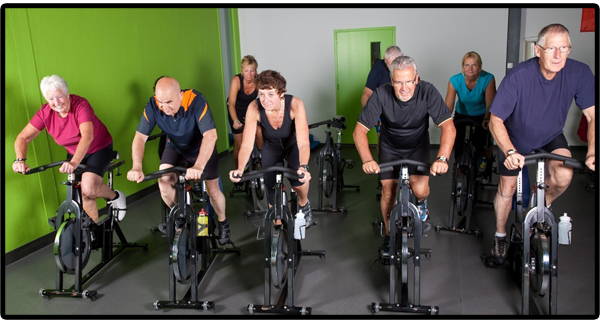This is the second in a series of posts concerning the benefits of exercise in our senior years, specifically our balance, disease, mental state and strength. In the first article we discussed how our ability to maintain our balance is critical to maintaining good health. Let’s address the effects of exercise on chronic disease.
Diseases such as heart disease, diabetes, COPD, and arthritis can all benefit by appropriate exercise. And as research shows can be reversed and sometimes eliminated.

Due to technological advances we have become a more sedentary society. While these advancements have made our life easier, the decline in our physical activity associated these has played a large role in the decline of our health.
A report published by the Surgeon General’s office in 1996 states that “The body responds to physical activity in ways that have important positive effects on musculoskeletal, cardiovascular, respiratory, and endocrine systems. These changes are consistent with a number of health benefits, including … reduced risks of Coronary Heart Disease, hypertension….” Your heart will become stronger with regular exercise. And the stronger it becomes the more it can endure the stress you place on it. The American Heart Association has established a sedentary lifestyle as a major modifiable risk factor for coronary heart disease (CHD). No randomized trials have been conducted to show the effects of physical activity on CHD. However many studies have shown an association between physical activity and CHD risk on the job. One study evaluated over 190,000 US railroad workers and showed that death caused by atherosclerosis was more frequent in the sedentary clerks than in the men who had a high rate of on the job physical activity. A similar study was done on 6531 San Francisco longshoremen for 22 years and determined that death caused by CHD was associated with calorie expenditure of sedentary workers.
Diabetics either produce too little or too much insulin. Regular exercise has been found to regulate these levels. The American Diabetes Association states that “exercise promotes the entry of glucose into the cells, helping the body to use its food supply more efficiently and to lower blood sugar levels”. For several years I have worked with diabetics in the gym. Some of which check their insulin levels before and after their workouts. Depending on the intensity of the exercises we perform, their blood sugar levels are affected.
COPD – Chronic Obstructive Pulmonary Disease. Exercise and the motivation to exercise is very challenging when someone has this lung disease. When you have difficulty breathing it’s very hard to even imagine working out. And then once the person becomes chronically sedentary they are even less likely to want to put the energy out to exercise. Having said all of this. Exercise is beneficial to those suffering with this disease.
In a study published in the Journal of Rehabilitation Research and Development, 8 weeks of comprehensive pulmonary rehabilitation (PR) were compared to education and medical management alone in 119 patients with severe COPD. Patients who exercised as part of their rehab were able to increase their walking endurance and decrease the symptoms of breathlessness and leg fatigue. It should be noted that most exercise that is appropriate for patients with COPD is focused on lower limbs since ambulation is a challenge. The benefits were maintained over several months. Aerobic conditioning also leads to reduced depression and improved cognition.
Exercise is crucial for people with arthritis. It will increase strength and contrary to what the person may be initially feeling will also increase flexibility. A paper published by the Mayo Clinic lists the benefits of exercise with those with arthritis as the following:
- Strengthen the muscles around the joint
- Help you maintain bone strength
- Give you more energy through the day
- Help you control your weight
- Improve your sense of well-being
They go on to state that lack of exercise will actually make your joints more painful and stiff.
In an article titled Role of Exercise in Arthritis Management and published by Johns Hopkins University. Susan Bartlett, Ph.D states that “Regular physical activity can keep the muscles around affected joints strong, decrease bone loss and may help control joint swelling and pain. Regular activity replenishes lubrication to the cartilage of the joint and reduces stiffness and pain.”
The moral of the story
Stand up and move. Take a break every hour on the hour and move for 5 minutes doing simple stretches or a walk around the block. There are many forms of exercise appropriate for people of all ages: cardio, strength training, yoga, Tai Chi, Pilates and more. Senior centers and independent living residences offer different fitness classes also.
In conclusion as the saying goes, “motion is the best lotion” and apparently the elixir your body needs even when you have been diagnosed with any of the above diseases. What will remain difficult will be creating the motivation, especially when you “just don’t feel good”. Education is key. Once someone becomes aware of what is necessary to live an improved life then hopefully this becomes the motivating factor.
Our next discussion in this series will investigate the effects of exercise on mental health while we age.
If you need help determining what’s right for you, your physical condition and health concerns, email or call me. Consultations are free and my goal is to help you get moving!
Bonnie Willard
I’ve read a few of these articles… And I can relate to more than a few of the stories. Im only 68 but have allowed myself to get so out of shape its scary.
How does your program work? Do clients come in to your gym once a week or more then work at home? What are costs?